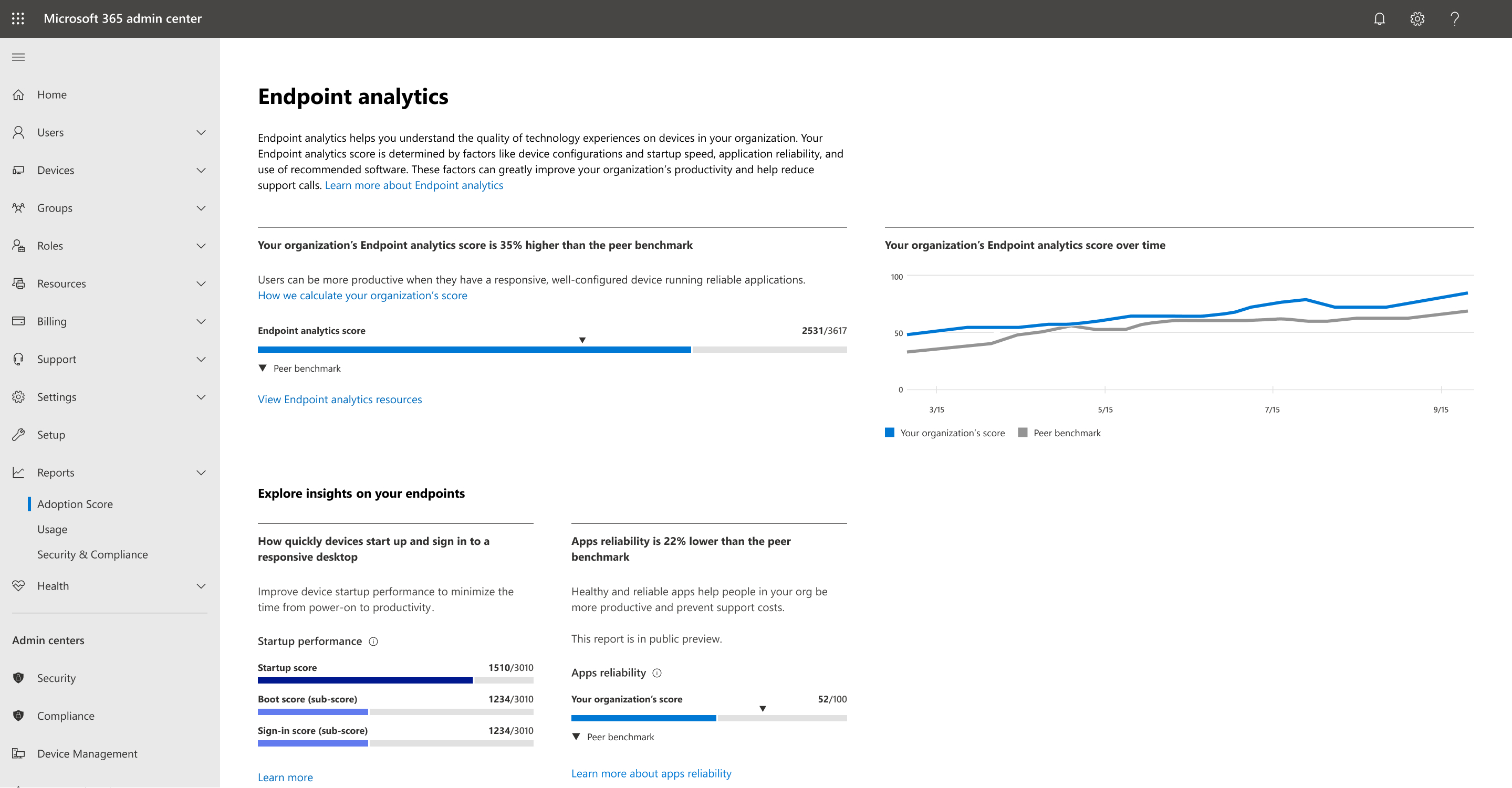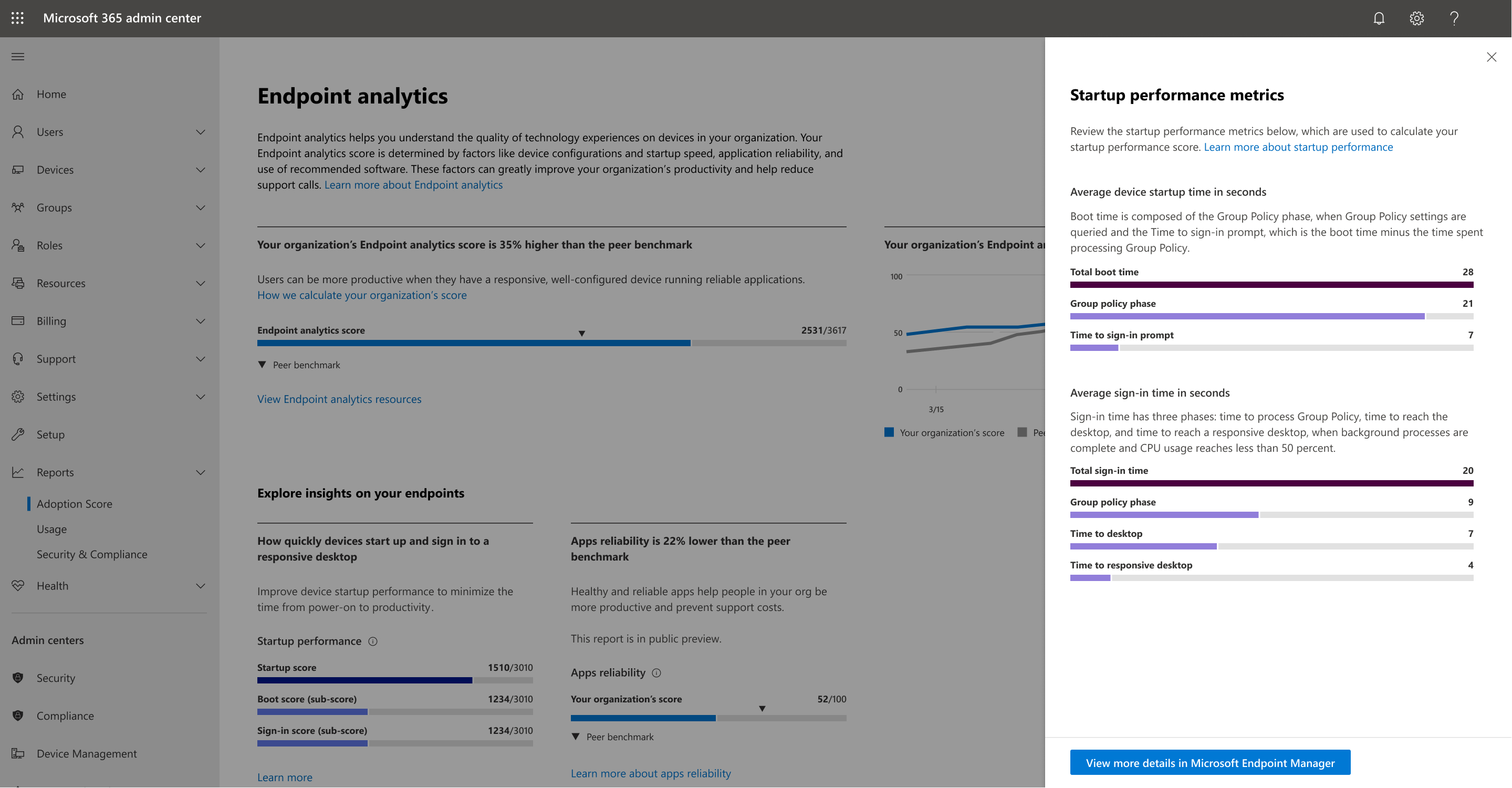Endpoint analytics in Microsoft Adoption Score
Understanding how your devices contribute to your end user's experience is critical to any digital transformation effort. Endpoint analytics information was added to the Microsoft Adoption Score to further your understanding. The Endpoint analytics page in Microsoft Adoption Score shares organizational level insights with the other roles outside of Microsoft Intune. The visibility and insights this provides in areas like device boot times and application reliability can help your users by highlighting potential issues within your organization. For instance, Endpoint analytics can expose a long sign-in process or issues with applications unexpectedly stopping.
Endpoint analytics page in the Adoption Score report
Endpoint analytics contains great insights, but most people couldn't see them since it requires access to the Microsoft Intune admin center. If you happened to be an Intune Admin or a Global Administrator, you could display the analytics. However, other users of Microsoft Adoption Score might be unaware this information exists. Displaying these insights to Microsoft Adoption Score users allows them to use the data to help drive transformation efforts across your organization.
The Endpoint analytics page looks similar to the other pages in Adoption Score, making it easy to dive right in. The following information is displayed on the Endpoint analytics page:
- The current Endpoint analytics score
- Endpoint analytics score over the past 180 days
- Startup performance scores
About the Endpoint analytics scores
The Endpoint analytics score is a weighted average of the Startup performance, Application reliability, and Work from anywhere scores.
The Startup performance score helps IT get users from power-on to productivity quickly, without lengthy boot and sign-in delays. The Startup score is a number between 0 and 100. This score is a weighted average of Boot score and the Sign-in score, which are computed as follows:
- Boot score: Based on the time from power-on to sign in. We look at the last boot time from each device, excluding the update phase, then score it from 0 (poor) to 100 (exceptional). These scores are averaged to provide an overall tenant boot score.
- Sign-in score: Based on the time from when credentials have been entered until the user can access a responsive desktop (meaning the desktop has rendered and the CPU usage has fallen below a moderate level or the device responds to an action initiated by the user). We look at the last sign-in time to each device, excluding first sign-ins or sign-ins immediately after a feature update, then score it from 0 (poor) to 100 (exceptional). These scores are averaged to provide an overall tenant boot score.
Startup performance metrics
Selecting the Learn more link under the startup performance information give you more details and a link to View more in Microsoft Intune. The Startup performance metrics are averages of the following items:
Average device startup time in seconds
- Total boot time: The combination of the Group Policy phase and the Time to sign-in prompt
- Group Policy phase: The time spent querying and processing Group Policy
- Time to sign-in prompt: Boot time minus the time spent processing Group Policy
Average sign-in time in seconds
- Total sign-in time: Total time for the Group Policy phase, Time to desktop, and Time to responsive desktop
- Group Policy phase: The time spent querying and processing Group Policy
- Time to desktop: The time it takes to reach the desktop but where background processes are still running, and users experience slower performance
- Time to responsive desktop: Time where background processes are complete and CPU utilization is less than 50%
Application reliability metrics
The overall Application reliability score for your tenant is shown with the peer benchmark in the chart. Selecting the Learn more about app reliability link under the app reliability information gives you more details and a link to View more in Microsoft Intune. The following Application reliability information is provided from Microsoft Adoption Score:
- Top apps reducing your score in the last 14 days
- App name: The app identifier in the file manifest provided by your client devices. The app name is typically in executable (or .exe) format.
- App reliability score: A score between 0 and 100 that represents the relative reliability of the application in your tenant. This score is calculated based on Mean time to failure and Total usage duration (14 days). A score of 0 represents an unreliable app that is likely hampering end-user productivity. A score of 100 represents a reliable app that is likely contributing to end-user productivity.
- Mean time to failure in hours: The average amount of engagement time that an end user is able to use the application before a crash occurs over the past 14 days. This value is calculated by dividing Total usage duration (14 days) by Total crashes (14 days). By relating usage duration and crash counts, the frequency of crashes across different applications is normalized. Applications without crash events in your tenant over the past 14 days are given a mean time to failure value of
No crash events. - Active devices: The total number of your tenant's enrolled devices that have launched this app at least once in the past 14 days.
Known issues
Unsupported roles
Currently, the following roles aren't supported:
- Exchange Administrator
- SharePoint Administrator
- Lync Administrator
Next steps
For more information, see:


